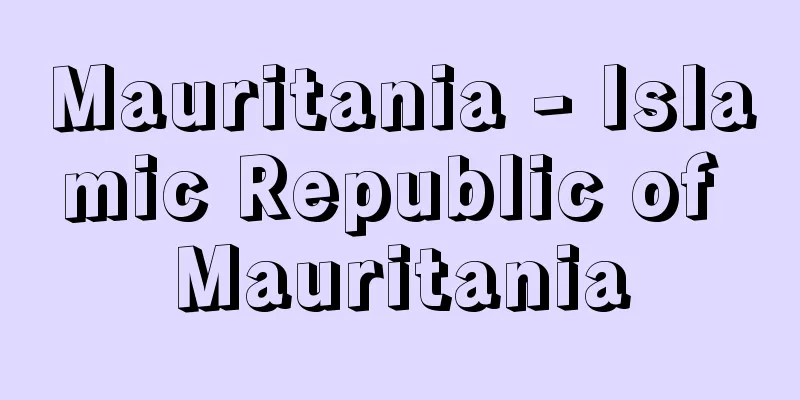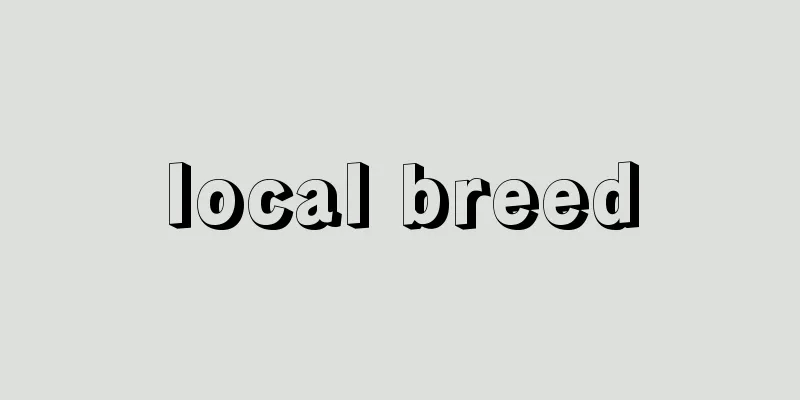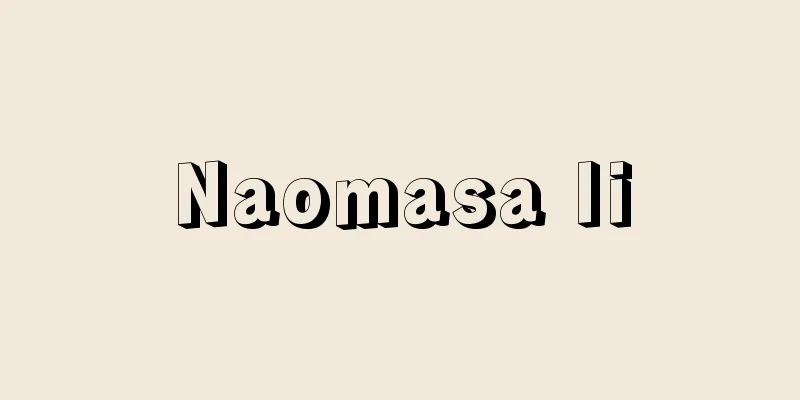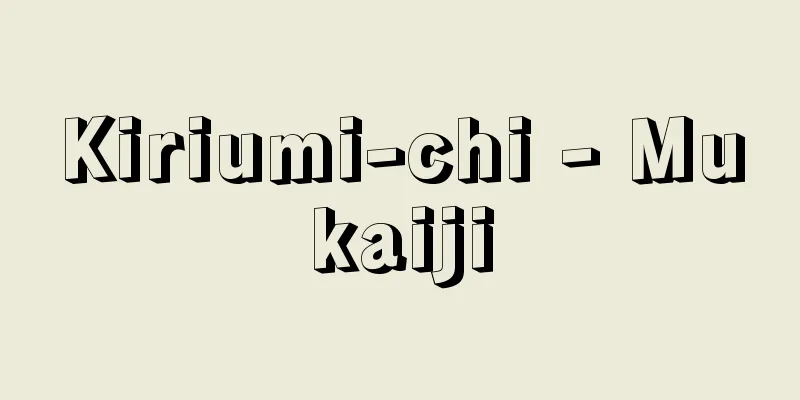Mauritania - Islamic Republic of Mauritania

|
A country in northwestern Africa, on the western edge of the Sahara Desert. Its official name is the Islamic Republic of Mauritania (Jumhuriyat Muritaniya al-Islamiya). It borders Western Sahara and Algeria to the north, Mali to the east and south, Senegal to the southwest via the Senegal River, and the Atlantic Ocean to the west. It has an area of 1,025,520 square kilometers, and a population of 2,906,000 (2005 estimate), 3,291,000 (2009 estimate). The capital is Nouakchott (population 673,000, 2007 estimate). [Hiroshi Fujii] NatureMost of the country is part of the Sahara Desert, but its foundations are Precambrian granite and gneiss, covered by Paleozoic sandstone and later sediments, and the terrain is generally flat. Apart from the coastal plain and the Senegal River basin, the inland areas are plateaus 200 to 500 meters above sea level, such as the Adrar Plateau and the Tagant Plateau, with steep cliffs along their edges. Oases are distributed at the foot of the plateaus, where spring water is found. A continental shelf stretches along the Atlantic coast, and the country is blessed with abundant fishing resources such as octopus, squid, sea bream, sole, and shrimp. Cape Blanc, a sandbar on the border with Western Sahara, is home to the natural port of Nouadhibou. Four-fifths of the country north of the 17th parallel has a desert climate with an annual rainfall of less than 200 mm, while further south it has a Sahel (steppe) climate with rainfall of 200-500 mm. The rainy season in the Sahel climate is centered in August and lasts for three summer months, but the amount of rainfall varies greatly from year to year, and severe droughts are common. Temperatures vary considerably between inland and coastal areas, but generally summers are hot and winters are cool at around 20°C. The inland desert is extremely hot during the day, but the temperature drops rapidly at night, with large diurnal ranges. In the north, it gets cold even during the day in winter. The coast is cool and easy to endure in summer due to the Canary Current (cold current). The area is often covered in fine sand blown from the desert by the northeast trade winds. [Hiroshi Fujii] GeographyThe country is divided into three regions: the Sahara region north of the 17th parallel, the Sahel region to the south, and the Atlantic coastal region to the west. The Sahara region is mainly inhabited by the Moors, who practice nomadic camel and sheep herding and oasis farming of date palms and vegetables. There is an ancient trade route linking the oases with North Africa and the Sudan region, and Attar is one of the transit cities on that route. Zourat in the north has high-grade iron mines. The population density is extremely low, and there are large areas of uninhabited land in the northeast. The Sahel region is inhabited mainly by Africans of Negroid descent, who cultivate millet, sorghum (a cereal grain of the grass family), and corn, as well as cattle breeding, and cultivates wet rice in the Senegal River basin. It is the most densely populated region in the country. Along the road to Mali and Senegal, there are agricultural product distribution centers such as Rosso, Kaédi, Aregu, Kifah, and Nema. The Atlantic coastal region has a wide continental shelf and the Canary Current, which is rich in nutrient plankton, making it a great fishing ground for octopus, squid, sea bream, shrimp, tuna, and other fish, and fishing villages are scattered along the coast. The iron ore export port of Nouadhibou is also a fishing base. Nouakchott is the capital and was newly built on fixed sand dunes where groundwater is available. It is the country's political, economic, transportation, and cultural center, and is also home to factories. A modern port was built with assistance from China. [Hiroshi Fujii] historyThis region has long been a place of contact between the north and south of North Africa and Black Africa. Since the 4th century, it has been under the control of the Ghana Empire of the Sarakore, a tribe of Sudanese (Negroid), but in the 11th century it came under the control of the Berber Almoravid dynasty and became Islamized. In the 13th century, as Islamic forces moved south, the Arab nomads Beni Hasan invaded and their Hasan dialect of Arabic became widespread. Due to the expansion of the desert, the Sudanese retreated south, and the Moors came to dominate this region and the Sudanese. In the 15th century, Europeans arrived and established trading bases on Arguin Island and other places, trading slaves and gum arabic. In the 19th century, it became a place of rival colonization by the UK and France, but in the early 20th century, France sent troops to occupy it and made it part of French West Africa. Resistance by the indigenous tribes continued, but in 1933 France succeeded in suppressing them and governing the region using the tribal rule structure. After World War II, as a French overseas territory, Mauritania began to send members to the local and national assemblies, and political parties were formed, with the Mauritanian Progressive Union, representing the conservative forces, winning a majority in the 1951 elections. In 1956, the Mauritanian local assembly formed an executive branch, and lawyer Moktar Ould Daddah (1924-2003) was elected Deputy Prime Minister (the Prime Minister was the French High Commissioner). In 1958, Mauritania became a republic under the French Community, and declared independence on November 28, 1960. In 1961, a constitution was enacted, and Daddah became the first president. The Mauritanian People's Party, which had united various factions, won all seats in parliament. In 1965, the People's Party was established as a one-party state, and President Dadda's pro-French policy continued to play a key role in the country's politics. However, the country was hit by droughts from 1968 to the early 1970s, and in order to deal with social unrest, it promoted Mauritanization, such as nationalizing a French-owned iron mining company in 1972. In 1975, an agreement was made with Morocco on the Western Sahara issue, and the country divided and took possession of Rio de Oro in the southern half of Western Sahara. However, the resistance of the Polisario Front, which aimed for independence for Western Sahara, led to war, and the economy worsened due to increased war expenses and the destruction of iron mines. In a coup in July 1978, the Dadda government, which had been in power for 18 years since independence, was overthrown, and the Military Committee for National Reconstruction (later the Military Committee for National Salvation CMSN) took full power. In August 1979, a peace agreement was made with the Polisario Front, and the country renounced its claim to Rio de Oro. [Hiroshi Fujii] PoliticsAfter the 1978 coup, the military-led CMSN (Military Committee for the Salvation of the Nation) took power, but internal power struggles led to repeated coups and political upheavals. In 1979, Prime Minister Busek took power but died in an accident, and after a dual leadership between his successor Prime Minister Haidara and Chairman Lurie, Prime Minister Haidara became chairman and president, wielding full power. However, he was ousted in a coup in 1984, and former Prime Minister Maaouya Ould Sidi Ahmed Taya (1943- ) became president. In July 1991, a new constitution was approved in a national referendum, which advocated democratization, including freedom of association and expression and direct presidential elections. In January 1992, Taya was elected in a multi-party presidential election, and the ruling Republican Democratic Socialist Party (PRDS) won a majority in the elections for both houses of parliament in March and April of the same year. In the second senatorial elections in November 1996, the PRDS won 17 of the 18 seats up for election, and in the lower house elections in October of the same year, it won 72 of the 79 seats. In foreign affairs, the country maintains a non-aligned neutral policy, and is deepening its ties with France and other Western countries. In the 1997 presidential election, Taya was re-elected. The ruling PRDS also won landslide victories in the 2000 senatorial elections, and in the 2001 local and parliamentary elections. In the 2003 presidential election, Taya was elected (for the third time and fourth term). In August 2005, the military staged a coup while Taya was absent, establishing the Military Council for Democracy, with Colonel Barre as its chairman. The parliament was dissolved, and a referendum was held to limit the president to one reelection. In the presidential election in March 2007, former Minister of Finance, Sidi Mahamed Ould Cheikh Abdallahi (1938-2020), was elected as President, and the country was transferred to civilian rule. On August 6 of the same year, the military staged another coup over personnel changes, arresting President Abdallahi, and Mohamed Ould Abdel Aziz (1956-), Chief of the Presidential Guard, became Chairman of the Council of State. In July 2009, a presidential election was held with nine candidates, and Abdel Aziz was elected. He took office as President in August of the same year. It was formerly a member of the French West African states, but after independence it leaned more strongly towards the Arab camp, and joined the Arab League in 1973. In 1983 it signed agreements of friendship and cooperation with Algeria and Tunisia, and in 1985 restored diplomatic relations with Morocco and Libya, with whom it had been in conflict over the Western Sahara issue. The army is conscripted, with a total strength of 15,650. [Hiroshi Fujii] economyIt was a traditional nomadic nation, but after independence, iron ore mines and fishing developed, and its per capita gross national income (GNI) was $840 (2007), somewhat high among countries in the arid regions of Africa. The economy deteriorated due to the war with the Polisario Front, and the country became highly dependent on foreign aid, with external debt reaching $2.3 billion in 1994, but the GDP growth rate remained positive in the second half of the 1990s. Livestock farming is a traditional industry of the Moorish nomads, with grazing land covering 38% of the country's land area and 53% of the working population engaged in it. The livestock numbers include 8.85 million sheep, 5.6 million goats, 1.69 million cattle, 1.6 million camels, and 4.2 million chickens (2007), which is more than five times the population. Meanwhile, arable land area is less than 0.5% of the country's land area, and agriculture is centered in the Senegal River basin, but harvests are vulnerable to drought. Agricultural products include 77,000 tons of rice, 17,000 tons of corn, 22,000 tons of dates, and 8,000 tons of watermelons (2007), but around 200,000 tons of food is imported each year. Fishing is a major industry alongside iron ore production, and marine products, mainly octopus and squid, are the largest export item. In the past, many foreign fishing boats from Japan, Korea, the Soviet Union, and other countries came to the area, and the fishing fees were a source of foreign currency. Since 1978, the country has restricted the entry of foreign fishing boats and has begun full-scale development of its fishing industry, nurturing its own fishing associations for both traditional and modern fishing using trawlers. Due to the seafood orientation of European countries, exports of fresh fish and prepared dishes by air have increased, and fishing by small fishermen has also developed. Iron ore is an export commodity along with marine products, with 7.65 million tons produced in 1974. After 1975, production declined due to the drop in demand for iron ore caused by the oil crisis and the intensification of the Western Sahara conflict, and production stagnated thereafter due to the recession, but recovered to 7.7 million tons in 2007. Iron ore is produced at the Zouerad iron mine near Fédérique, and is transported to the port of Nouadhibou on a 652-kilometer dedicated railway, the longest in the world, with 200 cars, for export. The reserves of this iron mine are showing signs of depletion, and development of the neighboring Germanic iron mine is underway. Exports are split between marine products (23.6%) and iron ore (68.6%) (2007), while main imports are machinery, food, petroleum products, automobiles, etc. Trading partners include France, Spain, and China. [Hiroshi Fujii] Society and CultureThe majority of the population is made up of Moors, a mix of Berbers and Arabs (Beni Hassan) who migrated from North Africa. Other Negroid peoples include the Wolof, mainly in the Loso, the Fulbe (Pulaar) and Tukulor in the Senegal River basin, and the Sarakole (Soninke) in the Malian border area. The Moors have a class system, and have been criticized by foreign rights groups for the existence of slaves, leading to the National Assembly passing an anti-slavery law in 2007 (10 years imprisonment for slave ownership). 56% of the total population lives in urban areas, with a particularly high concentration of population in the capital. The traditional nomads have decreased, and in 2000 they made up only 4.8% of the population. The official language is regular Arabic, but in daily life the languages of each ethnic group, such as French (formerly the official language), Hassanian (an Arabic dialect), Wolof, and Fulbe, are spoken. The adoption of regular Arabic as the official language has provoked opposition from the Negroid people. Islam is the state religion. Compulsory education is primary school (6 years), and the literacy rate is 55.8% (2007). Institutions of higher education include normal schools and technical colleges, and in 1983 a national university was opened in Nouakchott. The daily newspaper is Shaab (in French and regular Arabic), and there is national radio and television broadcasting. Two UNESCO World Heritage Sites have been registered: "Old Settlements of Ouadaan, Chinguetti, Tichit and Ouarata" (Cultural Heritage), and "Bandarguin National Park" (Natural Heritage). [Hiroshi Fujii] Relations with JapanIn the past, many Japanese fishing boats entered the coastal fishing grounds, and the Japanese government provided technical assistance to improve fishing techniques. In 1982, a fishing fee increase caused the Japanese fishing boats to withdraw, but now the country imports large amounts of marine products such as octopus, and also provides assistance in the areas of agriculture, rice, and vehicles. [Hiroshi Fujii] [References] | | | | | | | | | | | | [Additional information] |"> Mauritania flag ©Shogakukan Illustration/Shogakukan Creative "> Mauritania Location Map Source: Shogakukan Encyclopedia Nipponica About Encyclopedia Nipponica Information | Legend |
|
アフリカ北西部、サハラ砂漠の西端にある国。正式名称はモーリタニア・イスラム(イスラーム)共和国Jumhuriyat Muritaniya al-Islamiya。北は西サハラとアルジェリア、東と南はマリ、南西はセネガル川でセネガルに接し、西は大西洋に面する。面積102万5520平方キロメートル、人口290万6000(2005推計)、329万1000(2009推計)。首都はヌアクショット(人口67万3000。2007推計)。 [藤井宏志] 自然国土の大部分はサハラ砂漠に属するが、その基盤は先カンブリア時代の花崗(かこう)岩や片麻(へんま)岩で、その上を古生代の砂岩やそれ以後の堆積(たいせき)物が覆い、全般に地形は平坦(へいたん)である。海岸平野やセネガル川流域を除くと、内陸部はアドラル高原、タガント高原のような標高200~500メートルの高原をなし、その縁辺には急崖(きゅうがい)がみられる。高原の麓(ふもと)には湧水(ゆうすい)があるのでオアシスが分布している。大西洋沿岸には大陸棚が広がり、タコ、イカ、タイ、シタビラメ、エビなどの漁業資源に恵まれている。西サハラ国境に砂州状のブラン岬があり、天然の良港ヌアディブーがある。 北緯17度線以北の国土の5分の4の地域が年降水量200ミリメートル未満の砂漠気候で、それより南は降水量200~500ミリメートルのサヘル(ステップ)気候である。サヘル気候の雨期は8月を中心に、夏季3か月であるが、降水量は年による変動が大きく、よく大干魃(かんばつ)がある。気温は内陸部と沿岸部とではかなり異なるが、全体に夏は高温で、冬は20℃前後と涼しい。内陸部の砂漠は日中きわめて高温だが、夜は急速に気温が下がり、日較差が大きい。北部では冬は日中でも寒くなる。沿岸部はカナリア海流(寒流)のため夏も涼しくしのぎやすい。北東貿易風による砂漠からの細かい飛砂に覆われることが多い。 [藤井宏志] 地誌国土は、北緯17度線以北のサハラ地域、その南のサヘル地域、西の大西洋沿岸地域に3区分される。サハラ地域にはおもにムーア人Moor(モール人ともいう)が住み、ラクダ、ヒツジの遊牧やナツメヤシ、野菜のオアシス農業を行っている。オアシスを結んで北アフリカとスーダン地方を結ぶ古くからの交易路があり、アタルはその中継都市の一つである。北部のズエラートには高品位の鉄鉱山がある。人口密度はきわめて低く、北東部は無居住地域が広がる。 サヘル地域にはおもにネグロイド系のアフリカ人が住み、アワ、モロコシ(ソルガム。イネ科の穀物)、トウモロコシの栽培やウシの牧畜が行われ、セネガル川流域では水稲が栽培される。この国でもっとも人口密度の高い地域である。マリやセネガルへの道路沿いにロソ、カエディ、アレグ、キファ、ネマなどの農産物集散都市がある。 大西洋沿岸地域の沖合いは、広い大陸棚とプランクトンの栄養に富んだカナリア海流によりタコ、イカ、タイ、エビ、マグロなどの大漁場をなし、沿岸には漁村が分布する。鉄鉱輸出港ヌアディブーは漁業基地でもある。ヌアクショットは首都として地下水の得られる固定砂丘上に新しく建設された都市である。国の政治、経済、交通、文化の中心地で工場も立地している。中国の援助で近代的港湾が建設された。 [藤井宏志] 歴史この地方は古くから北アフリカとブラック・アフリカの南北両勢力が接触する場であった。4世紀以降、スーダン人(ネグロイド系)の一部族サラコレのガーナ帝国の勢力下にあったが、11世紀ベルベル人のムラービト朝の支配下に入りイスラム(イスラーム)化した。イスラム勢力が南下した13世紀にアラブ系遊牧民ベニ・ハサンが侵入し、彼らの話すハサン方言のアラビア語が普及した。砂漠の拡大もあってスーダン人は南へ後退し、ムーア人がこの地方とスーダン人を支配するようになった。15世紀にヨーロッパ人が来航し、アルギン島などに交易の拠点を置いて、奴隷やアラビアゴムの交易を行った。19世紀にはイギリス、フランスの植民地化の競合の場となったが、20世紀初めフランスは軍隊を派遣して占領し、フランス領西アフリカの一部とした。先住の諸部族の抵抗は続いたが、1933年フランスは鎮圧に成功し、部族支配構造を利用した統治を行った。 第二次世界大戦後、フランスの海外領土として地方議会、国会に議員を送るようになり、政党が結成され、1951年の選挙では保守勢力を代表するモーリタニア進歩同盟が多数を占めた。1956年、モーリタニア地方議会は行政府を組織し、副首相(首相はフランス人高等弁務官)に弁護士のダッダMoktar Ould Daddah(1924―2003)が選ばれた。1958年フランス共同体の共和国となり、1960年11月28日に独立を宣言した。1961年、憲法が制定され、初代大統領にダッダが就任した。議会は諸勢力を統合したモーリタニア人民党が全議席を占めた。1965年には人民党の一党制を規定し、その後大統領ダッダの親仏政策を基調とする政治が続いたが、1968年から1970年代初頭にかけ干魃(かんばつ)に襲われ、社会不安に対処するため1972年フランス資本の鉄鉱採掘会社を国有化するなどモーリタニア化を推進した。1975年西サハラ問題でモロッコと協定を結び、西サハラ南半のリオ・デ・オロを分割領有したが、西サハラの独立を目ざすポリサリオ戦線の抵抗で戦争となり、戦費の増大と鉄鉱山の破壊で経済が悪化した。1978年7月のクーデターで、独立以来18年間続いたダッダ政権が倒れ、国家再建軍事委員会(後の救国軍事委員会CMSN)が全権を握った。1979年8月にはポリサリオ戦線と和平協定を結び、リオ・デ・オロの領有を放棄した。 [藤井宏志] 政治1978年のクーデター以後、軍部を中心とするCMSN(救国軍事委員会)が権力を握ったが、内部の権力抗争により、クーデターや政変が繰り返された。1979年首相ブシェクが実権を握ったが事故死したため、後任の首相ハイダラと議長ルーリーの双頭体制ののち、首相ハイダラが議長、大統領に就任し全権を握った。しかし、1984年クーデターで失脚し、元首相タヤMaaouya Ould Sidi Ahmed Taya(1943― )が大統領に就任した。1991年7月、結社・表現の自由、大統領の直接選挙など民主化をうたった新憲法が国民投票で承認された。1992年1月、複数政党制による大統領選挙でタヤが当選し、同年3月、4月の上下両院選挙では、与党の共和民主社会党(PRDS)が多数を占めた。1996年11月の第2回上院選挙ではPRDSが改選18議席中17議席を占め、同年10月の下院選挙でも79議席中72議席を得た。外交では非同盟中立を基本とし、フランスをはじめ欧米諸国との関係を深めている。1997年の大統領選挙でもタヤが再選された。2000年の上院選挙、2001年の地方および議会選挙でも与党のPRDSが圧勝した。2003年の大統領選挙でもタヤが当選(3選、4期目)。2005年8月、軍がタヤ不在中にクーデターを決行、「民主主義のための軍事評議会」を設置し、バル大佐が議長に就任した。議会を解散し、大統領の再選を1度のみとすることを国民投票で決めた。2007年3月の大統領選挙で元財務相アブドライSidi Mahamed Ould Cheikh Abdallahi(1938―2020)が当選して大統領に就任、民政に移管した。同年8月6日人事をめぐってふたたび軍はクーデターを起こし大統領のアブドライを拘束、大統領警備隊長アブドルアジズMohamed Ould Abdel Aziz(1956― )が国家評議会の議長となった。2009年7月9人が立候補して大統領選挙が行われ、アブドルアジズが当選。同年8月大統領に就任した。 旧フランス領西アフリカ諸国の一員であるが、独立後アラブ陣営への傾斜を強め、1973年アラブ連盟に加盟した。1983年アルジェリア、チュニジアと友好協力協定を締結し、西サハラ問題で対立したモロッコおよびリビアとは1985年に国交を復活した。軍隊は徴兵制で、総兵力は1万5650人である。 [藤井宏志] 経済伝統的な遊牧国家であったが、独立後、鉄鉱石鉱山および漁業の開発が進み、1人当り国民総所得(GNI)は840ドル(2007)で、アフリカの乾燥地域の国のなかではやや高位にある。ポリサリオ戦線との戦争によって経済が悪化し、外国からの援助への依存が大きく、1994年の対外債務額は23億ドルに達したが、1990年代後半にはGDP成長率はプラスを保っている。 牧畜はムーア人遊牧民の伝統的産業で、放牧地は国土の38%に及び、就業人口の53%が従事している。飼育家畜数はヒツジ885万頭、ヤギ560万頭、ウシ169万頭、ラクダ160万頭、ニワトリ420万羽(2007)などで、総家畜数は人口の5倍以上に達する。一方、耕地面積は国土の0.5%以下にすぎず、農業はセネガル川流域を中心に営まれるが、収穫は干魃の影響を受けやすい。農産物は米7万7000トン、トウモロコシ1万7000トン、ナツメヤシ2万2000トン、スイカ8000トン(2007)などだが、毎年20万トン前後の食糧を輸入している。 漁業は、鉄鉱石の生産と並ぶ主産業で、タコ、イカ中心の水産物は最大の輸出品である。かつては日本、韓国、ソ連など多くの外国漁船が入漁し、その入漁料を外貨獲得源としていた。1978年以後、外国漁船の入漁を規制し、伝統的漁業とトロール漁船による近代漁業の自国漁業団を育成し本格的漁業開発に乗り出している。ヨーロッパ諸国のシーフード志向により、航空機輸送での鮮魚とその調理品の輸出が伸び、小漁民による漁業も発展している。 鉄鉱石は水産物と並ぶ輸出品で、1974年には765万トンを産した。1975年以後は石油危機による鉄鉱需要の落ち込みや西サハラ紛争の激化で生産が減少し、その後も不況で停滞していたが、2007年には770万トンと回復している。鉄鉱石はフデリック近郊のズエラート鉄山で産出され、全長652キロメートルの専用鉄道を、200両連結の世界最長の列車でヌアディブー港まで運ばれ輸出される。同鉄山の埋蔵は枯渇化傾向にあり、隣接するゲルマ鉄山の開発が進んでいる。 輸出品は水産物23.6%と鉄鉱石68.6%(2007)で二分し、おもな輸入品は機械類、食料品、石油製品、自動車などとなっている。貿易相手国はフランス、スペイン、中国などである。 [藤井宏志] 社会・文化住民は、北アフリカから移動してきたベルベル人とアラブ人(ベニ・ハサン人)の混血であるムーア人が人口の大半を占め、ほかにロソを中心にウォロフ人Wolof、セネガル川流域にフルベ人Fulbe(プールPulaar)、トゥクロール人Tukulor、マリ国境地域を中心にサラコレ人Sarakole(ソニンケSoninke)などのネグロイド系の人々が住む。ムーア人には身分制度があり、外国人権団体から奴隷の存在を非難され、国民議会は2007年に反奴隷法(奴隷所有に10年の禁固刑)を可決した。全人口の56%が都市部に居住し、とくに首都への人口集中は著しい。伝統的な遊牧民は減少し、2000年には人口のわずか4.8%となっている。公用語は正則アラビア語であるが、日常的にはフランス語(かつての公用語)、ハッサニア語(アラビア語方言)、ウォロフ、フルベなどの各民族集団の言語を話す。正則アラビア語の公用語化はネグロイド系の反発を招いている。宗教はイスラム教(イスラーム)が国教である。義務教育は小学校(6年)で、識字率は55.8%(2007)である。高等教育機関として師範学校、技術専門学校のほか、1983年にヌアクショットに国立大学が開校した。日刊紙は『シャーブ』(フランス語、正則アラビア語)、国営ラジオ・テレビ放送がある。ユネスコの世界遺産に「ウワダン、シンゲッティ、ティシットおよびウワラタの古い集落」(文化遺産)、「バンダルギン国立公園」(自然遺産)の二つが登録されている。 [藤井宏志] 日本との関係かつては沿岸の漁場に日本漁船が多数入漁し、日本政府も漁業技術向上のための技術援助を行ってきた。1982年(昭和57)の入漁料値上げで日本漁船は撤退したが、現在はタコなどの水産物を大量に輸入し、農業、米、車両などの援助も行っている。 [藤井宏志] [参照項目] | | | | | | | | | | | | [補完資料] |"> モーリタニアの国旗 ©Shogakukan 作図/小学館クリエイティブ"> モーリタニア位置図 出典 小学館 日本大百科全書(ニッポニカ)日本大百科全書(ニッポニカ)について 情報 | 凡例 |
Recommend
Opening - Kaihan
[noun] (suru) The act of carving new woodblocks an...
Elizaveta Petrovna
1709‐62 Russian Empress. Reigned 1741-62. Daughter...
Kerr, J. (physicist)
…the effect of electric and magnetic fields on th...
Malay literature
Malay literature in Malaysia. In addition to oral ...
Student group - gakuseidantai
... As a social institution, trade guilds and iti...
Kakitsuki
Military chronicle. 1 volume. Both the author and...
Appearance - Ougen
〘Noun〙 Buddhist term. When Buddhas, Bodhisattvas, ...
Nguyen Kim
… After the death of Thanh Thong, the imperial po...
Gyusoju - Gyusoju
Prime minister of the mid-Tang Dynasty in China. ...
Tanuma clan
His real surname was Fujiwara. He ruled Tanuma, As...
Onaruto Bridge - Onaruto Bridge
A suspension bridge that connects Magosaki, Ogeshi...
a priori language (English)
…Furthermore, Johann Martin Schleyer (1831-1912) ...
Epiphanes - Epiphanes
…Second son of Antiochus III. (Epiphanes) After h...
Comanthus japonica (English spelling)
...Many species of sea stars, including annelids ...
Cryptodromia canaliculata (English spelling)
… [Takeda Masatomo]. … *Some of the terminology t...









